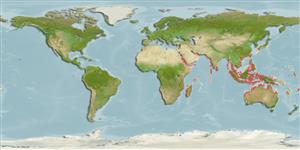Actinopterygii (ray-finned fishes) >
Perciformes (Perch-likes) >
Gerreidae (Mojarras)
Etymology: Gerres: Latin, gerres = a kind of anchovies; cited by Plinius. More on author: Cuvier.
Environment / Climate / Range
Ecology
Marine; brackish; demersal; amphidromous (Ref. 51243). Tropical, preferred ?
Indo-West Pacific: India and Sri Lanka to southeast Asia and the South China Sea. Reported in Iran (86648).
Size / Weight / Age
Maturity: Lm ? range ? - ? cm
Max length : 15.0 cm TL male/unsexed; (Ref. 3409); common length : 10.0 cm TL male/unsexed; (Ref. 3409)
Dorsal
spines
(total): 9;
Dorsal
soft rays
(total): 10;
Anal
spines: 3;
Anal
soft rays: 7. Scales between 5th dorsal fin spine base and lateral line 2.5-3 (usually 2.5). Second anal fin spine more robust than 3rd. Premaxillary groove without scales. Posterior margin of maxilla beyond a vertical through anterior margin of inner dermal eye opening. Diffused dark saddle patches along the back of live specimens 4 or 5: 1st saddle on nape; 2nd under second to 6th or 7th dorsal fin spine; 3rd beneath anterior soft part of dorsal fin; 4th beneath posterior soft part of dorsal fin; 5th on 1/3 upper caudal peduncle (or extending onto upper caudal peduncle or absent). Dorsal fin faint yellowish, with a dark patch on tip of spinous portion above a line running from middle of second dorsal spine to tip of 6th dorsal spine (rarely broader or otherwise indistinct with growth). Caudal fin pale yellow (often with a dusky trailing edge). Anal fin with anterior half yellow or dull orange, posterior whitish hyaline (Rarely dusky). Pectoral fins yellowish color, grading to hyaline at the tip. Pelvic fins yellow or dull orange (hyaline in Thai and Indonesian specimens). Supraneural bones 3.
Lives in tidal areas of estuaries and very shallow coastal waters. Feeds on small animals living on mud-sand bottoms. Marketed fresh (Ref. 3409).
Life cycle and mating behavior
Maturity | Reproduction | Spawning | Eggs | Fecundity | Larvae
Iwatsuki, Y., S. Kimura and T. Yoshino, 2001. Gerres limbatus Cuvier and G. lucidus Cuvier from the Indo-Malay Archipelagos, the latter corresponding to young of the former (Perciformes: Gerreidae). Ichthyol. Res. 48(3):307-314. (Ref. 41524)
IUCN Red List Status (Ref. 115185)
CITES (Ref. 94142)
Not Evaluated
Threat to humans
Harmless
Human uses
Fisheries: commercial
More information
Common namesSynonymsMetabolismPredatorsEcotoxicologyReproductionMaturitySpawningFecundityEggsEgg development
ReferencesAquacultureAquaculture profileStrainsGeneticsAllele frequenciesHeritabilityDiseasesProcessingMass conversion
Tools
Special reports
Download XML
Internet sources
Estimates of some properties based on models
Phylogenetic diversity index (Ref.
82805): PD
50 = 0.5000 [Uniqueness, from 0.5 = low to 2.0 = high].
Bayesian length-weight: a=0.01122 (0.00635 - 0.01981), b=2.99 (2.84 - 3.14), in cm Total Length, based on LWR estimates for this species & Genus-body shape (Ref.
93245).
Trophic Level (Ref.
69278): 3.5 ±0.37 se; Based on food items.
Resilience (Ref.
69278): High, minimum population doubling time less than 15 months (Preliminary K or Fecundity.).
Vulnerability (Ref.
59153): Low vulnerability (12 of 100) .
